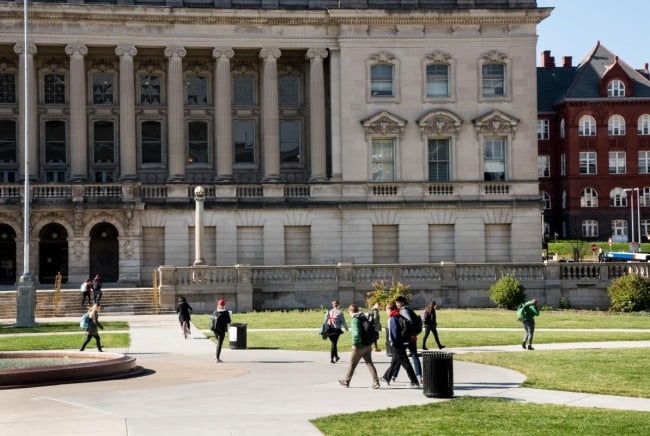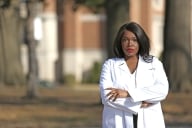You have /5 articles left.
Sign up for a free account or log in.

Faculty, staff and employees at all Wisconsin postsecondary institutions, such as the flagship campus at Madison, are eligible for Public Service Loan Forgiveness.
Education Images
When President Biden extended the pause on student loan repayment again last week, it renewed the debate about the federal Public Service Loan Forgiveness program, in addition to complaints about inefficiencies in how PSLF is administered and inadequate efforts to inform those eligible for it.
Rectifying past failures to approve applications and to clarify who is eligible for the program were part of the president’s plan for the previous and current repayment extensions—and part of that failure was due to college faculty, staff and other employees not knowing they were eligible, and considered public service workers, and not being informed of their eligibility by their universities.
Despite the extension of the pause on repayments, advocates for student loan borrowers continued to call for bigger and more meaningful changes in the program.
“Where we were before was not a coherent place to be,” Persis Yu, policy director for the Student Borrower Protection Center, said during a Twitter Spaces conversation on the day the Biden administration announced the pause on loan repayments. Yu added that even if borrowers were belatedly added to the PSLF program, the most vulnerable people—often people of color from low-income backgrounds now working in low-paying jobs—would still only get limited help. She said the best solution is total debt erasure.
“There are a lot of borrowers in the system who just shouldn’t be there anymore,” she said.
The Wisconsin Department of Financial Institutions has been working since last August to make sure eligible state residents and employees know how to get their student loans forgiven. State officials estimate that between 750,000 and 800,000 Wisconsin residents have student loan debt, which collectively totals $24.2 billion. They say the department’s programs and outreach have chipped away at the widespread distrust and skepticism about PSLF, led borrowers to financial freedom and informed people who were unaware that the program even existed
Cheryl Rapp, the department’s college investment program finance officer, recalled a recent conversation with the financial aid director of a state college as an example of the extent of misinterpretation and misunderstanding—including among people tasked with administering the program—about how PSLF works.
“I said, ‘Hey, you should talk to your employees and let them know they’re going to qualify because they work in a UW system college,’” Rapp said. “He said, ‘We don’t really qualify.’ I said, ‘You’re in education, you’re a civil servant, you actually qualify and your employees qualify.’ He didn’t feel a need to inform his employees about the Public Service Loan Forgiveness.”
She said it took a while to convince the financial aid director that the program was designed for people like him and his employees.
“It blew my mind—really, they were in financial aid, and they didn’t understand what this was about,” she said.
The disconnect may have been surprising, but it was not unusual. The U.S. Department of Education announced in October that it would improve its methods for finding and informing people who are eligible for PSLF and processing their applications, but the department was still struggling to develop a strategy to do it as of December. Even now, its efforts to contact potential loan-forgiveness applicants has been slow, with the nationwide total of recipients still at just 100,000 as of March.
Wisconsin is one of a just few states with a dedicated process for informing employees working in higher education–sector jobs that they are eligible for the PSLF program—and not just those at four-year colleges and universities.
“We encompass it all—technical, two-year, apprenticeship, whatever,” Rapp said.
Dave Mancl, director of financial literacy at the Wisconsin Department of Financial Institutions, said those eligible also include “Staff in school districts, staff in universities—they’re not teaching, they’re not faculty, but they’re public employees, so they’re eligible. School counselor, custodian. Everybody.”
Rapp, Mancl and others in the department have been holding informational webinars, targeting 260,000 public employees and 215,000 retired public employees, since last August as part of the Wisconsin Strong financial education program. The department has partnered with Savi, a technology company, to create a tool to help borrowers determine their eligibility for loan relief or loan consolidation programs. Mancl said the webinars and other outreach led 1,114 people to register with Savi for guidance on programs like PSLF as of April 7. He said registered users have received an average of $21,294 in loan forgiveness.
The troubled history of the federal program, which had rejected some 98 percent of applicants before the Biden administration pledged to overhaul the system, drove away a substantial number of potential loan-forgiveness recipients.
Mancl said many people just do not believe that the program will help them, or that their application for it will be accepted. “So we really just have to sound the alarm,” he said.
The state of Washington last week signed into law a plan similar to Wisconsin’s that will create and fund agencies and assign staffers and advocates to promote the PSLF program and get more information out to potentially eligible public service workers. Some 767,000 Washington residents have student loan debt, according to state estimates.
“This program is a great way to help those who have decided to serve our state, and I’m eager for more folks to benefit from it now that this bill has been signed into law,” State Senator Marko Liias, who introduced the bill, said in a statement.
While such efforts by states will likely help more eligible people apply for and receive loan forgiveness, U.S. Senator Patty Murray, who represents Washington State, said the Biden administration would have to radically change its approach in order to reach more people, including by “creating a new Public Service Loan Forgiveness program that works for our public servants,” she said in a statement. “This is not too much to ask for: so I continue to urge the Biden Administration to deliver for student borrowers—and I continue to push the Administration to extend the pause until 2023 to make sure this all gets done before payments resume.”
The rewards for those who learn from the webinars that they are eligible are enormous and emotional, Mancl said. Borrowers are often surprised when they go on the website of the U.S. Department of Education to track how much they owe and discover that their public service employment had suddenly cleared their entire debt.
“As we were on one webinar,” Mancl said, “People were looking up things on the Department of Education site or their direct loan sites and discovering, ‘I’m getting $17,000 waived. So, I’m done.’ That’s huge money.”
Rapp remembered a webinar participant who said she had checked her balance in the morning and saw it was at $120,000, and after applying for forgiveness that same day, she later checked again and her balance was cleared. “She freaked out—she said, ‘Oh my gosh, it got forgiven today. Now it says my loan is 100 percent paid off, forgiven.’ So it’s really cool.”
The department plans to keep holding webinars throughout the period of the loan-payment pause because the need is so great and the information is so lacking. When the pause is eventually lifted and payments resume, Rapp and Mancl noted, borrowers who haven’t had to make any loan payments during the last two years because of the pandemic-induced repayment pauses will need to understand how much they actually owe and whether some or all of their balances can be erased through the PSLF program.
“It’s a call to action for all the universities,” Mancl said, “because they can help their own employees get money in their pockets. Part of our job is that this is dollars that can come back to Wisconsin, and if you miss it, you miss out. And that would be a shame.”








